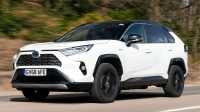The reader will find out what wheel rims are and what their diameters are. You will also find out the differences between steel and alloy wheels. Whether or not to change the wheel to a wider one, and what the consequences are.
The Rav4 SUV's rims fail after long drives on dirt roads, rocky terrain. Not only do the tyres burst, but the rims also crack. If a wheel has a small crack, it is best to replace it.
Which rims are suitable for the Toyota Rav 4 In order to determine which tyres and rims will be required on the Toyota Rav 4 when replacing it, refer to the following table. It gives the dimensions of diameter, offset and width of the components.
Car model and make (year) Tyres Rims RAV 4 1994 – 2000 215/70 R16 235/60 R16 RAV 4 2000 – 2006 235/60R16 6.5-7×16 5114,3 d60-60.1 ET35-45 RAV 4 2006 – 2013 215/70R16 215/65R17 245/55R18 6.5-7×16 5114,3 d60-60.1 ET45 7×17 5114,3 d60-60.1 ET45 7.5×18 5114,3 d60-60.1 ET45 RAV 4 c 2013 225/65R17 235/55R18 7×17 5114,3 d60-60.1 ET39 7.5×18 5114,3 d60-60.1 ET45
ET stands for wheel offset in millimetres. It is measured between the rim and mounting symmetry planes. It is best to avoid buying wheels with a non-standard offset. It could butt into the brake assembly. This table shows the original factory fitted wheels and tyres. Caution! If the Toyota Equal 4 is factory-fitted with 17-diameter rims, the car owner may choose to install one size larger. These discs will look great on the SUV, and the car will be more stable on a slippery track.
What's the difference between alloy and steel rims?
In addition to dimensions, you should also look at the material used to make the wheels. Typically steel or aluminium alloys with a mixture of other metals are used to give strength and the ability to support the weight of the Toyota Rav 4 vehicle with and without a load. Cast or alloy wheels are the standard for all vehicles produced by vehicle wheel companies. They are outwardly beautiful and efficient. Wheel companies have started to add nickel to aluminium, which gives a lighter weight. Wheels made from aluminium and steel differ in weight for the worse. They make the car unmanoeuvrable on the road, the vehicle cannot reach speed in the seconds indicated by the manufacturer in the owner's manual. The lighter the tyres, brake discs and pads, the better the car's grip on the ground or asphalt. The weight can be an advantage in winter. It presses the car harder against asphalt, and therefore, it will not drift on a slippery road. Therefore, it is desirable to change not only tyres when "re-shoeing" your car, but also wheels. In winter one should use steel ones, in summer - the ones made of light-alloy material.
Warning! Steel wheels do not exceed 16" in diameter. Because of their weight, the braking system may not be able to brake the vehicle. For this reason, 17 and 18-inch wheels are rarely made from steel. Alloy material is used here.

Cast and forged Alloys are in turn divided by the type of manufacture: cast; forged. The former consist of fine-grained metal. This structure causes micro-cracks all over the disc when driving on unpaved and rocky roads. They may not show themselves externally for a while. Then, after another bump on a stone or a speed bump, they may split in two. In the city and at high speed, the car will immediately create an emergency situation. A forged wheel comprises a plastic and fibrous metal structure. These wheels will easily crumple the suspension in a hard impact, but will not break. They are several times more expensive than cast wheels.

Replacement instructions Steps in the procedure to change a wheel. Park on level ground. Loosen the four bolts that hold the vehicle's wheel. jack up the side where the wheel is to be replaced. Slacken the bolts as far as they will go. Remove the wheel and mount a new wheel on the Toyota Rav 4. Screw in the bolts. Remove the car from the jack. Retighten the bolts. Drive the car a couple of kilometres and retighten the four bolts if they are loose. Now the car owner knows which wheels to put on the Toyota Rav 4 vehicle and how to properly do the procedure for replacing the wheels. Conclusion When buying wheels, it is necessary to choose according to the diameter of the hole in the centre. Since if the car owner makes a mistake and buys a wheel with a smaller diameter, he will not put the wheel on. The tightening torque of all wheels must also be identical. They are tightened using three methods: cone, flat, and sphere.




